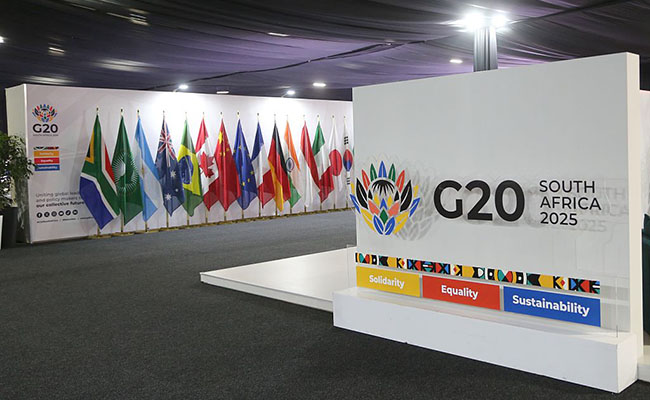It’s rare to hear a top investment manager describe himself as a “nervous Nellie”. But Marius Oberholzer, head of multi-asset at Stanlib, doesn’t shy away from admitting just how volatile and uncertain the global investment landscape has become.
“There have been major systemic shifts,” he tells Currency. “It’s the most exciting macro environment in my career of 25-26 years.”
Exhilarating, yes, but also deeply unsettling. As the world grapples with the aftershocks of aggressive monetary policy, unpredictable decisions from the White House, shifting global trade patterns and resurgent geopolitical tensions, even the most seasoned investors are treading carefully.
The weakening dollar, along with growing debate over “US exceptionalism” and whether the world’s biggest economy still deserves its status as the safest and most dynamic place to invest, is reshaping global capital flows and challenging the premium traditionally paid for American assets.
All these converging forces come as Oberholzer, who chairs the asset allocation meetings at South Africa’s second-largest money manager, has just led his team through their latest round of strategy deliberations.
“We can’t really, with huge amounts of conviction, know what’s going to happen,” he says, adding that current conditions instead call for adaptive thinking. “It’s not a cycle of high conviction; rather, it’s about navigating uncertainty with flexibility and precision.”
Or “granularity”, as Oberholzer likes to emphasise. In other words, moving beyond broad asset classes (like equities or bonds) to make more nuanced, specific and tactical choices within and across them.
A fractured global picture
Oberholzer, whose team manages assets spanning absolute return, multi-strategy and hedge fund mandates, outlines a world economy pulled in opposing directions. Most countries, facing slowing growth and easing inflation, are cutting interest rates – some at the fastest pace seen in decades. But in the US, where inflation is proving sticky and fiscal largesse under President Donald Trump looms, the Federal Reserve remains hesitant.
At the same time, Japan has hiked rates for the first time in more than 15 years as it faces the unfamiliar challenge of inflation. Europe is grappling with inflation that has just reached its target, while increasing military spending. China, meanwhile, is battling deflation, weak domestic demand and a weak currency due to its peg against the dollar.
Oberholzer is sceptical about prevailing views that the dollar will continue weakening. The dollar fell almost 11% against a basket of currencies in the six months through June, its worst first-half performance since 1973, as geopolitical turmoil and Trump’s renewed trade war rattled markets.
“We’re not convinced that the dollar’s decline is sustainable,” he says. “The dollar will remain the reserve currency. That’s not going anywhere. Most of the world’s reserves are still held in dollars, though some diversification is under way. We wouldn’t be surprised to see the dollar exhibit some strength from here against all currencies. How long that lasts is another thing.”
Looking at riskier debt
Oberholzer’s team is also rethinking the traditional reliance on sovereign debt, particularly as central banks appear to be edging back towards yield-curve control. By issuing more short-term paper to ease pressure on longer-dated bonds, policymakers are managing interest rates more directly – a response to rising debt loads and the need to stabilise markets amid surging government borrowing.
“Why would you want to own sovereign debt at 4% when they’re going to control the curves and you’ve got fiscal and monetary policy working at odds with one another?” he asks. “Meanwhile, high-yield credit offers yields of 7%-8% with far more attractive risk-reward dynamics.”
Sales of risky European corporate debt hit a record high in June, driven by a decline in borrowing costs and increasing investor demand, the Financial Times reported, citing JPMorgan data. Junk-rated issuers are taking advantage of lower borrowing costs as investors divert allocations away from US assets amid concerns over Trump’s trade volatility and the government’s increasing funding needs.
Oberholzer says US stocks remain attractive, despite rallying to record highs and the widespread belief that they’re trading at historically high valuations amid fears that US economic growth is slowing and that inflation will rise again.
This, of course, is where “granularity” once again matters, particularly in the technology sector. Here, he highlights the hyperscalers – giants like Amazon, Microsoft and Google, which are driving the AI boom with massive capital investment in data centres, cloud infrastructure and computing power. While he acknowledges that the market rally has been narrow, primarily driven by the mega-cap stocks, earnings growth, robust cash flows and balance sheets that aren’t highly geared with debt justify this, particularly with companies like Nvidia.
“AI is here to stay. It’s a secular change,” he says. “We’re moving from a manufacturing to a service-based economy – and the profitability that these companies are seeing, in terms of demand and usage, does change things.”
Oberholzer argues that the US still offers the most investable environment for innovation-led equity exposure due to its well-regulated markets and deep liquidity.
Big on Japan
In Japan, the team is betting that the yen will reverse its gains and weaken against the dollar, serving as a catalyst that will benefit Japanese exporters and support a rally in Japanese equities, particularly as the Bank of Japan cautiously manages interest rate increases. The Nikkei is trailing the US and Europe in terms of performance this year.
While Oberholzer isn’t convinced the dollar’s recent slide will continue, others see further room to run. Standard Chartered, in its global market outlook released in June, forecasts a weaker dollar over the next six to 12 months and has upgraded Asia (excluding Japan) equities and local-currency emerging-market bonds to an overweight position.
“A weaker dollar historically supports returns across risk assets, particularly in emerging markets,” Ayesha Abbas, the bank’s head of wealth solutions for Europe, the Middle East and Africa and the United Arab Emirates, says in a note. The bank views this as a “critical moment” for global investors to reposition their portfolios with increased international diversification, particularly in non-US equities and emerging-market debt.
The Stanlib team is less convinced of the case on emerging markets, preferring to take a more selective stance, assessing each nation individually, and digging deeper into each developing country’s asset classes and their opportunities.
Closer to home, Oberholzer acknowledges the appeal of South African sovereign bonds but flags rising concern within Stanlib’s fixed-income team, mainly due to the government’s worsening fiscal position, political uncertainty, and the lack of tangible action to spur economic growth.
“I think we do need to hold some sovereign,” he says. “And the real return that we get from South African sovereign bonds is high. But it’s been like that for the last six or seven years.”
Steady hands
On the rand, Oberholzer notes that its recent strength against the dollar is more a function of dollar weakness than domestic strength: “We could see some continued rand strength versus the dollar. But we haven’t seen rand strength versus the euro, pound, the Aussie or the other crosses.”
He also points to recent commodity price movements as a potential tailwind for South Africa. “The oil price is going down. Our commodity prices are going up, specifically gold and platinum, which boosts the country’s exports and improves South Africa’s terms of trade.
With all the market volatility, investors still have tools to manage risk, and one of the most effective, says Oberholzer, is the use of options. These financial instruments give investors the right, but not the obligation, to buy or sell an asset at a set price in the future.
“Option markets are a really cheap way to control your risk,” he says, adding that Stanlib is using them tactically to protect portfolios from potential losses while retaining the ability to make profits from possible gains.
Experience counts in times like these.
“The beauty of sitting in a team like ours is that we get to debate this stuff all day, every day,” Oberholzer says.
The outlook is for more volatility, with a hint of optimism and pockets of opportunity.
“It’s going to be bumpy – we can’t underestimate the structural changes that are under way,” he adds. “There’s always new information. That’s what makes markets so wonderful: you never quite figure them out. They’re always moving and evolving.”
This article was produced in partnership with Stanlib.
Top image: Rawpixel / Currency collage.
Sign up to Currency’s weekly newsletters to receive your own bulletin of weekday news and weekend treats. Register here.













